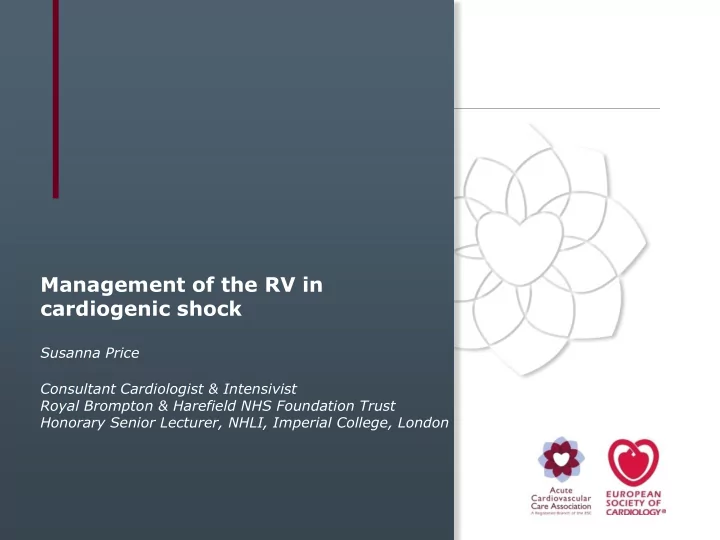

Management of the RV in cardiogenic shock Susanna Price Consultant Cardiologist & Intensivist Royal Brompton & Harefield NHS Foundation Trust Honorary Senior Lecturer, NHLI, Imperial College, London
Disclosures No disclosures/conflicts of interest •
Cardiogenic shock
80% 70% 60% ICU mortality 50% 40% 30% 20% 10% 0% MOF Haem-onc RVI revasc Sepsis SARF ARF RVI no revasc Lupi-Herrera et al., World J Cardiol, 2014 SCCM data, 2015. Parakh et al., Int Med J, 2015
Cardiogenic shock management ✓ Revascularisation ✓ Device therapy ✓ Structural Improved survival with Cardiogenic shock/AHF good QoL Medical treatment? ✓ Inotropes ✓ Intubation ✓ Electrolytes Oral Heparin GP IIb/IIIa Bivalirudin Beta blockers antiplatelets inhibitors & -ve inotropes & pressors & ventilation Volume Nutrition Endocrine Care bundles Multi-organ failure Death cardiology >>>>>>>>>>>>>>>>>>>>>>>>>>>>>>>>>>>>>>>>>>>> critical care
Guidelines, 2016 Complex, management requires understanding of anatomy and mechanics, Identification Treat underlying causes Support Uncertainties remain
Volume? CVP: +ve predictive value 47% PCWP: +ve predictive value 54%
RV preload optimisation Initial studies: • • Normal saline infusion, maintaining RAP <10mmHg Later clinical studies • • Variable response reported • Aim target PCWP 18-24 mmHg Berisha et al., 41 patients, electrocardiographic and haemodynamic • criteria for RV infarction – maximal RV SWI with filling pressure 10-14mmHg - mean RAP >14mmHg associated with RV distension - haemodynamic response variable - optimal PCWP (corresponding to maximum LVSWI) 16mmHg Inohara et al., EHJ Acute Cardiovascular Care 2013
RV preload optimisation Smaller studies: Change in PCWP and CI Wide variation in response No linear association with higher mRAP target Practically: Aim transmural pressure 8-12mmHg Measure CO and ScvO 2 /systemic organ perfusion ( not well-studied in acute RV failure ) Inohara et al., EHJ Acute Cardiovascular Care 2013
1. Preload evaluation 3. RV afterload evaluation PVR normal: need increased RVEDP IPPV: Increases ITP PVR elevated: increase in RVEDP will shift septum Hypovolaemia: Sepsis/SIRS Vascular permeability Insensible loss P syst reduced by analgesia & sedatives 4. Septal involvement 2. Pressure-volume 5. The pericardium
Vasoconstriction Dopamine Noradrenaline If >15mcg/kg/min is α -agonist Constrictor • • Positive inotrope Antithrombotic • • Elevation in PCWP Positive inotrope • • 1678 patients with circulatory shock – 280 cardiogenic
Systemic arterial pressure optimisation Perfusion RV free wall: difference in RV free wall tension and coronary • artery pressure Volume resuscitation that increases RV free wall tension without increasing • systemic pressure can decrease RV perfusion Ideal pressor: increase systemic arterial pressure – no change in PVR • Harjola et al., Eur J Heart Failure 2016
Positive inotropic agents Diverse collection of pluripotent molecules • Differing pharmacological properties • Some shared activities – only one of which is positive inotropy • Will increase dP/dt with variable effects on cardiac output/index • Alteration in myocardial oxygen demand • Arrhythmia • Additional: Alteration in bacterial metabolism and translocation • Alteration in inflammatory markers and ROS • Immune-modulatory effects • Coagulation • Differential effects on macrocirculation & microcirculation •
Cardiac output: global vs regional perfusion? Regional resistance: • neurohumoral factors related to inflammation and the sympathetic nervous system • local factors related to autoregulation Key (neglected) organs: • GIT (gastric tonometry, splanchnic/hepatic saturations, indocyanine green) • Brain
Each inotropic agent: efficacy vs toxicity Each inotropic agent • Each organ system • • Cardiac • Renal • Hepatic • Cerebral • GIT • Microcirculation Each pathological situation: • • Sepsis • AMI+CS • DCM+CS • Haemorrhagic shock In context of different ICU • interventions
Which inotrope? • No real evidence to support one over another
Afterload reduction Critical illness frequently associated with increased PVR • HPV – alveolar, pulmonary arterial/bronchial arterial hypoxaemia, worsened with • acidemia Focus on : • • Reducing pulmonary vascular tone • Judicious use of pulmonary vasodilators • Awareness of the effects of positive pressure ventilation Aim: normoxia, normocarbia Lung volumes near FRC pH normal RV FRC TLC Ventetuolo & Klinger, Ann Am Thorac Soc 2014
Potentially injurious effects of ventilation Spontaneous Ventilated Tavazzi G, ESICM 2014
Effects of IPPV in RV restrictive physiology Inspiration increases E/A ratio • Abolishes PA diastolic wave • Relative contribution of • “restrictive” antegrade a wave to forward flow: • Inspiration: 7 +8% • Expiration: 22 +10% 43% patients with SARF • Inducible by IPPV • Cullen, Circulation. 1995 Mar 15;91(6):1782
Pulmonary vasodilators None approved for treatment of RV failure in critically ill • All have systemic & pulmonary effects • Systemic administration may alter V/Q mismatch, and worsen hypoxaemia • Speaker Harjola et al., Eur J Heart Failure 2016
Right heart afterload Pulmonary TAPSE Maximal pulmonary vasodilatation • iNO + Levosimendan + Nebulised prostacyclin + Low dose vasopressin + Nebulised milrinone Speaker
Peripheral VA-ECMO 23Fr venous, 19-21Fr arterial (Legmo: 10-12Fr) Cardiac (or cardiopulmonary) support Percutaneous, rapid access Awake or ventilated Up to 8L/min – high, stable flow, 2-4 weeks Better kit – transportation and monitoring Cheaper than Tandem Heart and Impella Expanding indications
Guidelines? ??RV failure
Transfemoral insertion 3D shaped cannula 22Fr motor housing Pump on 1Fr catheter 4L/min @33,00rpm ACT160-180 COHORT B: 58.3% survival (cohort predicted survival 40%)
Statement from ESC
Many interventions seem physiologically/intuitively sensible – but that doesn’t mean they are right Sir Iain Chalmers, co-founder Cochrane collaboration, BBC Radio 4, 2013
Recommend
More recommend